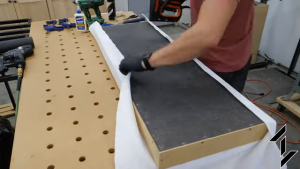DIY Soundproof Room Divider: Step-by-Step Guide
Most DIY soundproof room dividers are usually made of fabric or heavy drapes. These materials do not offer much soundproofing, but they are the cheapest diy soundproof room dividers available. If you want something more substantial, you will need to buy specialty materials like acoustical foam boards or high density fiberglass insulation panels. This post will show you how to make your own DIY soundproof room divider that is better than store bought ones!

Why Use a Soundproof Room Divider?
There are many reasons why you might want to use a soundproof room divider in your home or workspace. Maybe you need to create a home office in a shared space, or you want to block out noise from a busy street. Perhaps you’re a musician or content creator who needs a quiet space to work, or you simply want to create a private area in a multi-purpose room. Whatever your reason, a soundproof room divider can help reduce noise and provide some much-needed privacy.
Additionally, if you live in an apartment building and share walls with your neighbors, using a soundproof room divider can help reduce the amount of noise that travels between apartments. The soundproof room divider will muffle the noise as well as dampen your children or dogs’ noises, whether you’re making a recording studio, a streaming studio, or just want some peace and quiet from your roommates.
What Materials Can Be Used for Making a Room Divider?
- Fabric or curtains: This is one of the easiest and most affordable options for making a room divider. However, it doesn’t provide much soundproofing or privacy.
- Acoustical foam panels: These are designed specifically to absorb sound, making them a good option if you need to reduce noise levels.
- High-density fiberglass insulation panels: These are similar to acoustical foam panels in their sound-absorbing properties, but are more expensive.
- Wood or metal frames: These can be used to create a more permanent and sturdy room divider. You can attach various materials to the frame, such as fabric, glass, or even bookshelves.
- Glass or plexiglass: If you want a room divider that lets in natural light and maintains visibility, glass or plexiglass panels can be a good choice.
- Bamboo or other natural materials: These can create a unique and aesthetically pleasing room divider, but may not offer much in terms of soundproofing or privacy.
Ultimately, the material you choose will depend on your specific needs, budget, and design preferences.
What Materials Do You Need?
Depending on your diy project, you’re going to need different items for this diy. If you want a simple soundproof room divider then the main item you’ll need is acoustical foam panels.
To make a simple soundproof partition of your own, you will need:
- 4ft x 8ft acoustical foam panels
- scissors
- felt fabric
- paint roller/paint brush
- craft glue
- duct tape
- sharp razor blade/knife
- 4 inch plastic pipe
- miter/hack saw
How to Make Your Soundproof Room Divider

Here are the steps to follow to create your DIY soundproof room divider:
- Cover the panel with your favorite fabric and lay it on the floor. Then, using a pair of sharp scissors, trim the cloth just enough to give yourself an overhang.
- Wipe the glue off with a clean, dry cloth initially to remove any excess and make sure there’s enough glue on the surface before proceeding. Apply a generous amount of white glue to the panel using a paint roller or paint brush to avoid it drying too quickly. To thin the white glue, add some water. Hurry so that the glue doesn’t dry while you work.
- Remove any wrinkles from the cloth and allow it to dry.
- Trim the hanging fabric with a sharp razor blade or craft knife once it has dried.
- The perimeter of the panel should be covered using two inches duct tape. The ugly yellow foam core will be hidden and the panel will have a more completed appearnace.
- The length of the four-inch pipe is four feet, so you may get two foot lengths from a single piece. You can make one four-foot long piece of four-inch pipe out of one piece by cutting it at the halfway point. Cut a channel in the pipe 1/8 inch smaller than the thickness of your panel after finding the midpoint of your panel’s thickness.
- Cut the channel nearly all the way through the pipe, leaving about 2 inches of piping in place at the bottom using a miter or hack saw. A multi-purpose tool with a saw blade attachment or you can drill a few tiny holes and use a scroll saw to make a sideways cut.
- Attach the feet by standing your room divider upright and sliding the panel into the foot while spreading the channel apart. It should fit quite snugly, as the foam panel will compress a little.
These lightweight and easily transportable walls may be used to separate rooms for privacy, sound reduction, or warmth. A single 4ft x 8ft panel costs about $50 and takes around 30 minutes to put up.
Video: DIY Room Divider Using Card Board Boxes Rental Friendly
DIY Soundproof Room Divider: FAQ
What can I use as a footer?
Try sharpening some tiny diameter (1/4″) wooden rods, say 12 inches long. Ram a few into one panel and a few into the other panel, then push them together.
Can I use this to block sound coming in?
While the diy soundproof room divider will help reduce noise levels within the room, it is not designed to completely block out exterior sounds. If complete sound insulation is what you are looking for, then you should consider installing double-pane windows or adding another layer of drywall to your walls.
Will this work if I want to divide my studio into two rooms?
Yes! This DIY project can easily be adapted for dividing a studio into two separate spaces. Just make sure to use a heavier fabric or add another layer of drywall to the walls for better soundproofing.
What type of glue should I use?
White glue is a good option, but you could also use construction adhesive, contact cement, or spray adhesive. Be sure to read the instructions on the adhesive before using it to avoid any problems.
Can I paint my room divider?
Yes! You can paint your diy soundproof room divider with any color that you like. However, if you are looking for better sound insulation, then you should avoid painting the panels with thick coats of paint as this will reduce their ability to absorb sound waves.
Final Thoughts
A DIY soundproof room divider can be a cost-effective and customizable way to create privacy or reduce noise in your home or workspace. With a few simple materials and some basic DIY skills, you can create a soundproof room divider that’s perfect for your specific needs. Give it a try and see how much more peaceful and private your living space can be!



